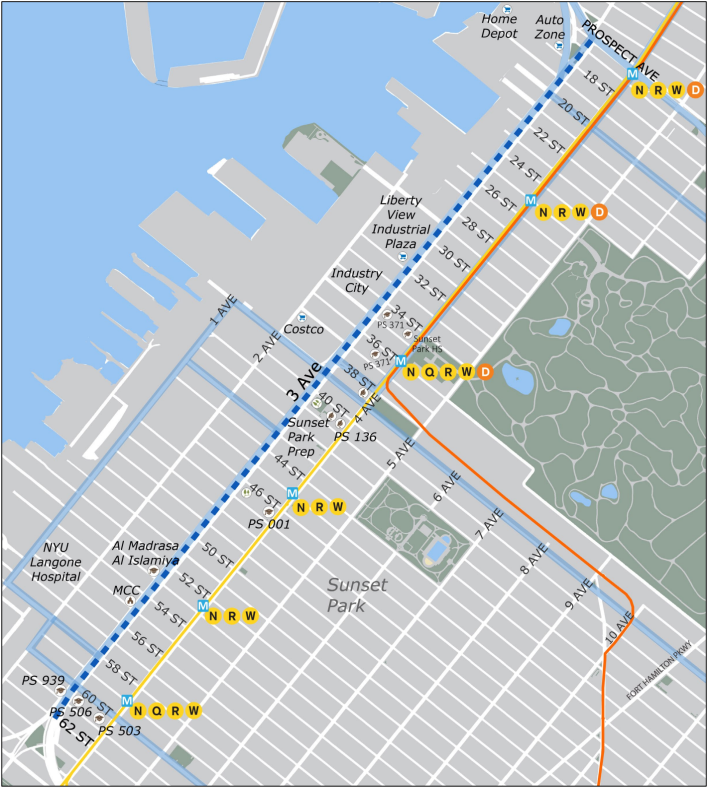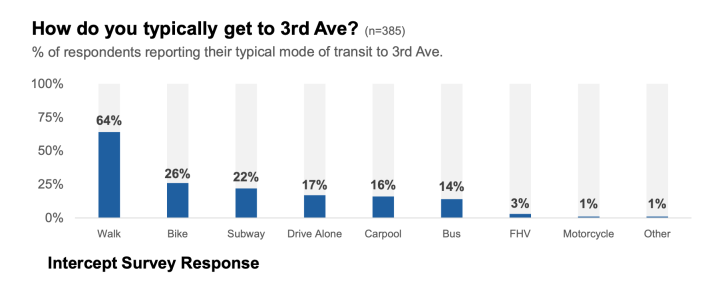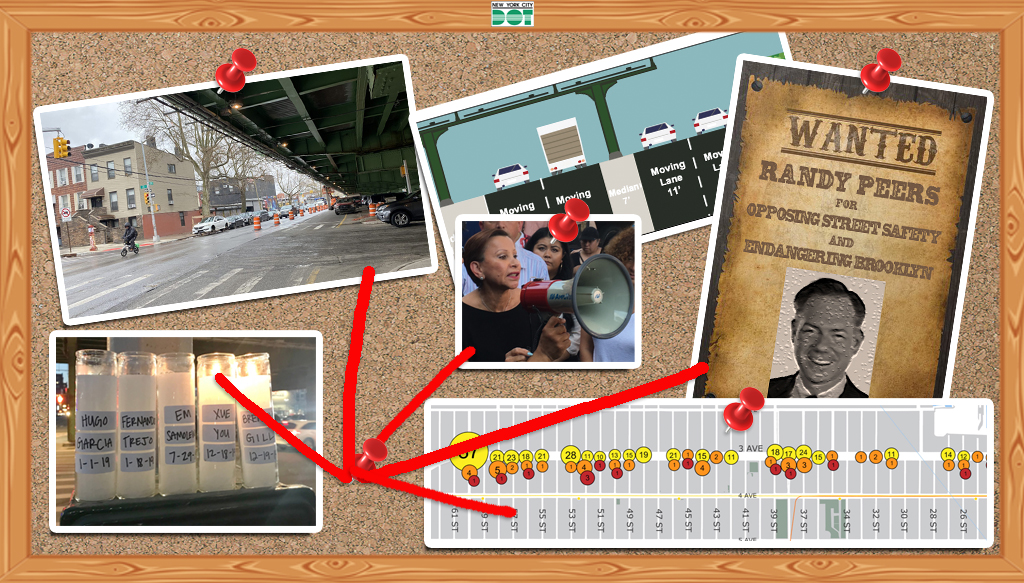The city has enabled business honchos to stymie a vital street safety redesign on Third Avenue in Brooklyn, based on unproven fears that the road diet will harm their bottoms lines.
The Department of Transportation was set to move forward on a road diet for the corridor in Sunset Park, until business leaders with the Brooklyn Chamber of Commerce protested the proposed lane removals and the Adams administration postponed the plans until at least 2026.
It's another case of Mayor Adams backing off proven safety improvements in the name of business interests or more "public input." In reality, the result has been that the Adams administration has lost its own transportation ground war to opponents of bike lanes and bus lanes and a handful of non-transportation experts who have no interest in safety.
"The idea that just a few people can complain in a very lame and generic way and derail something like this is absurd," said Jon Orcutt, a DOT official under Mayors Mike Bloomberg and Bill de Blasio who is now the director of advocacy at Bike New York. "This is supposed to be one of the greatest city’s in the world and we let so much stupidity invade what we do."
So what happened on Third Avenue? Let's see:
Decades of danger
With the Robert Moses-era Gowanus Expressway roaring overhead, Third Avenue has been a dark and dangerous six-lane thoroughfare for decades, and locals have been pushing the city to improve safety along the corridor.
Between 2018-2022, a startling 634 people were injured in crashes – more than two a week, according to DOT data (the average number of injuries is consistent for 2023 and 2024, according to data reviewed by Streetsblog). The Sunset Park stretch of Third Avenue and adjacent streets is home to 12 schools.

But the latest impetus towards fixing Third Avenue began in 2019 after drivers killed 27-year-old Fernando Trejo near 52nd Street and 26-year-old bagel delivery worker Hugo Garcia near 28th Street in January alone.
Later that year, a tractor-trailer driver fatally mowed down 30-year-old Em Samolewicz after she was doored into traffic near 35th Street, and in December, a truck driver killed 85-year-old Brendan Gill near 39th Street.
Garcia's former employer told Streetsblog that Third Avenue needed safety improvements.
"If it saves lives, of course, it’s good," the owner of Bagels By the Park, who gave only the name Jim, said in a phone interview with Streetsblog. "It is dangerous. There’s no bike lane over there."
In late 2023, DOT released a slate of three possible options to overhaul Third Avenue, between Prospect Avenue and 62nd Street, including a road diet that would cut the number of car lanes down to four and install a curbside parking-protected bike lane and painted pedestrian islands
The agency had worked with local electeds and CB 7 in the lead-up to the plans, which officials forecast to be in place by last summer or fall. DOT reps conducted workshops and on-the-ground surveys of residents and 127 businesses in spring of 2023.
Despite the Third Avenue's "Mad Max"-style design, an overwhelming number of people still get there without a private vehicle, according to another survey by DOT.
Nearly two-in-three (64 percent) walk, while 26 percent bike, 22 percent take the subway, and 14 percent ride the bus. Just 17 percent drive alone. (The numbers add up to more than 100 percent due to people using multiple modes.)

A whopping 68 percent of respondents backed removing a parking or driving lane for safety improvements, and the same percentage said there should be a protected bike lane on Third Avenue, a DOT "street ambassador" survey in Industry City found.
"I live within 10 blocks of Industry City and yet never go there because of how incredibly hostile Third Avenue is to bicycles (my main form of transport). There is NO safe bike infrastructure in this area," one public commenter told DOT.
"There are so many lanes that invite speeding, and because of this there are more severe injuries," said another person, according to the agency.
Community Board 7 in early 2024 endorsed the road diet and protected bike lane in nearly unanimous vote. The design mirrors the road diet and bike lanes a block away on Fourth Avenue, which has logged drastic declines in crashes over the past decade, undoing its history of being one of the most dangerous thoroughfares in the borough.
Business pushback

Within weeks of CB7's vote, Brooklyn Chamber of Commerce CEO Randy Peers showed up to the community board's next monthly meeting to dress down the civic volunteers, accusing them of choosing the "most disruptive and radical option" without consulting local businesses enough.
The Chamber circulated its own biased web survey, that listed concerns without evidence that the changes could worsen "loading and unloading operations," and "reduce customer volume due to traffic and lack of parking options."
The questionnaire also asked whether the protected bike lanes were even needed given the protected lanes on Fourth Avenue and the unprotected lanes on Fifth Avenue.
The responses to its survey were "clear, the road diet was not welcomed and would be very disruptive," Peers previously told Streetsblog.
Summer and fall came last year without DOT moving forward on the project, and last month, an agency liaison told CB 7 leaders not to expect any work this year, punting safety to the next mayoral administration.
Business owners along Third Avenue that spoke to Streetsblog did indeed echo Peers's opposition to the project, but that is common before the implementation of safety projects and the resulting improvements to safety and to businesses' bottom lines.
"It’s very very jammed. When you take away a lane, it’s more traffic," said Ahmed Mohamed, the owner of Pizza & Bagels On 3rd, at the corner of 20th Street. "Cycling [safety], I can understand, but taking away a lane from cars, it’s crazy."
"It will create more traffic and headaches," echoed Benny Cheung, the owner of Lucky 99¢, a discount store on Third near 43rd Street. "If the avenue stays like this, it will be safe." (City statistics show that it is not currently safe.)
Some business owners do support the road diet because of Third Avenue's current danger.
"It sometimes feels like if you’re in some sort of sinister game to see if you can just get to other side of that road," said Peter Kruty, who runs a letterpress printer just off Third Avenue on 40th Street. "It’s really terrible, it definitely needs to be addressed."
Another local bookshop manager said having cycling infrastructure and better pedestrian access would be a "game changer."
"[Third Avenue] is a huge natural barrier," said Chris Molnar, a manager at Powerhouse Books in Industry City. "It’s pretty bleak to cross."
"Biking out here isn’t really possible," Molnar added. "It could really be a game changer."
Into the breach of opinion is supposed to be the facts of the DOT, but the agency's press office refused to refute the concerns or defend its work. Agency spokesman Vin Barone simply referred back to a previous statement saying that the agency will "continue to collect feedback" — a common refrain under Mayor Adams whenever a street safety project is on the chopping block.
Road diet data
Because DOT is unwilling to stand up for itself, Streetsblog dug through decades of studies in the Big Apple and beyond showing that road diets curb traffic violence with few to no negative side effects.
Reducing the number of car lanes has been a commonly-used tool for street safety upgrades in New York City and across the country for decades at this point, and there is plenty of research out there detailing their benefits.
Just a block over on Fourth Avenue, which also used to have six lanes, DOT installed a road diet in 2012, and pedestrian injuries dropped by 29 percent in Sunset Park, and by a whopping 61 percent on the northern stretch in Park Slope, according to agency data.
The city in the late 2010s added a curbside parking-protected bike lane to Fourth, though that treatment still abruptly ends at the Bay Ridge border.
Third Avenue counted a death tally more than three times as high as Fourth between 2016 and late 2023, according to DOT, and the proposed road diet would largely mimic its safer design.
The federal government has also long boosted the benefits of road diets, with the United States Department of Transportation detailing a "mythbusters" fact sheet [PDF] discrediting the common notion that road diets worsen traffic. [Editor's note: That page has been removed from the federal site under President Trump, evidence that even basic data about safety is part of today's culture wars.]
Roadways might already operate like they have fewer lanes, because drivers often use one lane for turning, according to the federal agency's two-pager.
In the case of Third Avenue, several sections were routinely narrower than the six marked lanes because of double-parked vehicles or construction.

Another review by the feds of road diets [PDF] found that traffic congestion did not worsen, nor did trips spill over onto other streets.
For example, in Seattle, Washington, officials narrowed the four-lane Stone Way to two lanes, while adding a bike lane, in 2007. There were opposing businesses along the way airing eerily similar concerns to those on Third Avenue.
"We need to move traffic, particularly trucks. It’s not a good idea to narrow the street down because traffic will overflow on other streets. This is our arterial," the paper says, citing one business owner.
After the project went in, traffic counts actually went down on that street by six percent, and dropped by as much as 34 percent on parallel streets. The corridor was also able to carry the same number of vehicles during the peak hour despite the fewer lanes.
Some cities installed road diets to actively revitalize an area, such as a street in Grand Rapids, Michigan, where one of the goals of narrowing a roadway and adding bike lanes was to "improve business environment, commercial activity, and sales," according to the federal study
Even if there were a little less capacity, that can be a good tradeoff for substantial safety increases, while boosting cycling and walking trips, US DOT's "mythbusters" factsheet argues.
Those safety gains can be huge, as the New York City's own DOT has found. Road diets reduce the rates of people killed or seriously injured in crashes by 30 percent on average, according to an agency evaluation of its street safety treatments over 13 years.
Another dedicated road diet survey found even steeper reductions in crash injuries when looking at specific road diets. On Ninth Avenue in Chelsea, the city cut one of four lanes and installed a parking protected bike lane, yielding a 52 percent drop in injuries.
Orcutt, of Bike New York, said there always will be some opposition, but a successful transportation agenda requires city leaders to stick to the facts and not vibes-based doomsaying.
"You just do it, because you know it’ll work," said Orcutt. "You have leadership in the city that is willing to listen to technical expertise and make the streets safer."
"We just don’t have that at all right now," he added.






